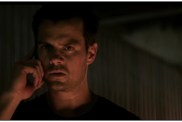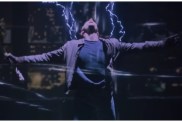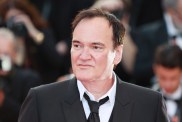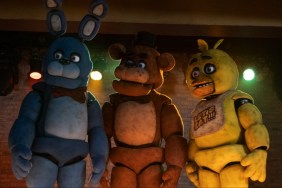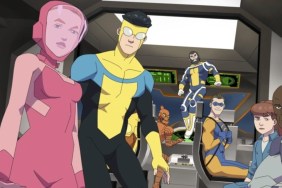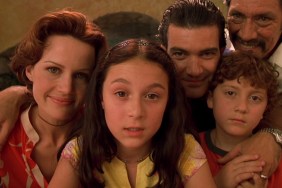Robert Patrick talks Terminator 2: Judgment Day
Director James Cameron’s iconic sci-fi action classic returns in pristine clarity when Terminator 2: Judgment Day arrives on 4K Ultra HD Combo Pack (plus Blu-ray and Digital HD) December 26 from Lionsgate. In celebration of the release, ComingSoon.net chatted with the T-1000 himself, actor Robert Patrick! We discuss the pressure of landing the role, being a CGI effects pioneer and replacing Billy Idol in the role. Check out the interview below!
Click here to pre-order your copy of the Terminator 2: Judgment Day 4K Blu-ray!
Loaded with bonus content, including an all-new, never-before-seen documentary featuring commentary from the cast and crew (including James Cameron, Arnold Schwarzenegger, and Edward Furlong), the groundbreaking masterpiece written by James Cameron and William Wisher will be available for the suggested retail price of $22.99.
BLU-RAY / DIGITAL HD SPECIAL FEATURES
*NEW* “T2: Reprogramming the Terminator” 55 Minute Documentary Including Exclusive Interview with Arnold Schwarzenegger, James Cameron, Edward Furlong and More
2 Feature Commentaries including 23 members of the cast and crew, including director James Cameron and co-author William Wisher
“The Making of T2” 30 Minute Featurette
Seamless Branching to View 3 Different Versions of the Movie
2 Deleted Scenes with Audio Commentary
Trailers
Terminator 2: Judgment Day shattered the definition of action-filmmaking to become one of the most celebrated sequels of all time. Even in an age of anything-is-possible digital blockbuster filmmaking – with onscreen action often entirely fabricated and “unreal” – T2 remains a touchstone for both filmmakers and movie fans on the use of visual effects, fusing high-tech thrills with an emotional and compelling story.
The film stars Arnold Schwarzenegger (The Terminator franchise, Total Recall, The Expendables franchise), Linda Hamilton (Dante’s Peak, The Terminator, TV’s Beauty and the Beast), Edward Furlong (American History X, Detroit Rock City, Pecker) and Robert Patrick (TV’s Scorpion and The X-Files, Walk the Line).

ComingSoon.net: Does it really feel like 26 years or does it feel like yesterday?
Robert Patrick: It feels like yesterday and it feels like 26 years ago. A little bit of both. Certainly I know of everything I have done in the 26 years after that, yet I can recall vivid memories of everything that went on in the making of “Terminator 2.” It was an incredible movie and it deserves to be seen in 3D. This visual remastering is amazing and its conversion to 3D is just fantastic. But I think the film is as relevant today as it was the day it came out, if not more so.
CS: Well it’s interesting because through the years it has become such an iconic classic. At the time when it was made, James Cameron was really taking a huge gamble because this was the most expensive movie of all time. The first “Terminator” was a success but it wasn’t like “Star Wars,” it wasn’t a huge blockbuster, and Cameron was coming off “The Abyss,” which had disappointed. Did you feel any of that pressure during the shooting?
Robert Patrick: Oh yeah, without a doubt. Look I was a complete unknown when I got cast. I worked with Roger Corman and on “Die Hard 2” and done a couple plays. I could feel the pressure all around. There was pressure put on myself because I didn’t want to let anyone down: I didn’t want to let Jim down, I didn’t want to let Arnold down, I didn’t want to let myself down. I wanted to do the job. I had been given this wonderful gift of an opportunity to play the T-1000 and I wanted to take full advantage of it and do a great job. Certainly a man like Cameron was a visionary. Cameron is one of those guys that understands that you’ve got to get in there, you have got to get in the ring and fight, you’ve got to make mistakes, you’ve got to take your hits. You’ve got to hit back, you gotta be willing and courageous and bold enough to do things that will make people stand back and look at you in awe. And that’s what you’ve got to be willing to do. You don’t get to have a breakout hit, and you don’t move cinema forward by playing it safe. You do it by being bold and having the confidence, and the cojones to gamble and reach for the stars. And that’s what Jim is. He is a visionary filmmaker and he doesn’t sit back and wait to see what people are going to say about it. He just goes and pushes for it. Everybody can sit back and see what he does, just sit there and go, “Wow this guy is an amazing filmmaker.”
CS: Did you and Jim bond over the fact that you were both Roger Corman alumni?
Robert Patrick: Oh absolutely. Right after he cast me he said, “Hey, I heard you worked for Roger Corman.” “Yes sir,” I said. And he said, “That’s where I started too. So I know what you went through there.” So we commiserated about that. Commiserated is not the right word, we were both very proud of the fact that that was a part of our legacy, where we had gotten our start. Without Roger Corman, Jim Cameron wouldn’t have gotten his start. Without Roger Corman, Robert Patrick wouldn’t have gotten his start, and a whole lot of other people would not have gotten their start. Roger Corman is certainly the conduit for a lot of people that got their first opportunity in show business, in the motion picture industry for sure. That is without a doubt.
CS: As Corman likes to say, “if you do a good job, you will never have to work for me again.”
Robert Patrick: Absolutely, but you know, what a great guy he is. I mean, if Roger Corman never existed and created what he created, there would have been no Jack Nicholson.

CS: Yeah. Or Scorsese, or all of those guys – Jonathan Demme. And it’s interesting how you’ve talked about how you replaced Billy Idol after his motorcycle accident. And actually, I’ve seen some of Jim’s concept art of Billy in the role. I want to know in what ways did you change the equation in terms of Cameron’s conception of the character once you were cast in the role?
Robert Patrick: Well, I came in from an actor’s perspective, and several things happened. I mean, I am an actor and I came in with an actor’s point of view, I was not a personality, and you don’t have my personality all over T-1000. You have an actor coming at a role trying to lose himself in the role, not the other way around. You don’t have a personality coming in to try to dominate a role. So that is probably the first and foremost thing: I approached it totally from the performance art part of it. “How do I physically become this? How do I manage this guy Jim Cameron’s vision of this? Who he wants this to be?” The audience did not have any pre-conceived notion of who I was, and they were much more willing to accept me as the T-1000 and the entity of the T-1000. Whereas, if you were to have someone who was a known entity playing that part, that would have taken away from the…
CS: The mystique?
Robert Patrick: It would have taken away the integrity of the film by a degree. At that point it would have just become, “Well that’s Arnold Schwarzenegger and Billy Idol going at it.” And I have met Mr Idol and he is a wonderful guy, I am not saying that he would have been incapable of doing it – I am saying that it is a whole different thing. I was not a known anything. So the audience was able to take that journey a little bit more willingly with me than had it been a known entertainer playing that part.
CS: I think you are selling yourself a little bit short, because another aspect of it is that Idol has a much more straightforward scary appearance, whereas you brought this neutrality to the T-1000. You brought this neutral look which I think makes it scarier because you do not know your character’s intentions.
Robert Patrick: And that was purposely done. The fact was I wasn’t supposed to be threatening. That was the thing that Jim and I discussed early on: “You are the baddest thing on Earth, you don’t have to act like you are bad.” I totally got that, I was like, “Yeah, I’m the baddest thing on the Earth, I don’t have to act like I’m bad.” The performance is not, “oooh I’m a bad guy,” the performance is, “I am a mimetic polyalloy and I am able to change and can become anything I want to become.” And I am an artificial intelligence. “Where would I get my software to program me?” For the performance, I went to the natural world and studied predators. I approached it from the Animal Kingdom, so I did a very organic, non-sophisticated way of approaching a sophisticated role: by making it very natural. What does a predator look like? So it was never about, “I’m a badass, look how tough I am,” it was completely the opposite. How does an eagle look? How does an insect look? How do predators look? It’s much more of a stalky, panther, cat-like sort of a thing. It’s not just a “let me kick your ass” type of thing. I don’t have to threaten you. I just am.

CS: It is interesting, piggybacking off of that, the fact that your character is the “big bad” was sort of ruined by the marketing. If you were going into T2 cold, you wouldn’t necessarily know which is the bad guy until you and Arnold are in the hallway with John.
Robert Patrick: Well that was the way it was supposed to be. And I can remember back when the movie came out, Jim and everyone talking to me about the big reveal: “We don’t want anyone to know about you. We don’t want anyone to know about the character. You are the reveal, so you are the secret.” And if I remember correctly that was how it was marketed. I don’t think that they showed any image of me at all when they were selling that movie. All they knew was there were two Terminators and one comes back to save John Connor and Sarah Connor, and one comes back to target them. When you saw the movie you went, “Holy f*ck, Arnold is the little guy!”
CS: In what ways did you modulate your performance so you didn’t tip it for the audience in that first act?
Robert Patrick: Well there was nothing I did that was threatening.
CS: Even when you killed that first police officer for his clothes it looks like you were just punching him, but you’re probably slicing him through the stomach.
Robert Patrick: Right, but you didn’t see me do that.
CS: Yeah, it’s hidden.
Robert Patrick: When Arnold got his clothes in the bar, he beat the sh*t out of people, he didn’t kill anybody but he beat the sh*t out of them. Then he got his clothes and went on his merry way. So his introduction in the movie compared to my introduction was more violent and much more visceral. Where mine was more meticulous, cold, and eccentric… and less messy.
CS: Is there anything people generally don’t understand about the rigors and trial and error that Dennis Muren and all of those Industrial Light & Magic guys went through with you to create the computer-generated aspects of the T-1000?
Robert Patrick: I’ve said this many many times, the T-1000 is a group effort. It is a whole ensemble of people that came together to make the T-1000 the T-1000: It’s the part that I brought, it’s Jim Cameron’s vision, it’s Stan Winston and his animatronics, it’s Dennis Muren and ILM. It’s all those parts together. My part was to create a common denominator for everything to make it seamless. That you would accept all the different elements that were happening. And it is all under the conducting of Jim Cameron. Everything that we did was groundbreaking: technology and performance. It was like acting under a microscope. It had to be precise, it had to be exact, you could not do it just so-so. You have to do it exactly right and it was frustrating. It was literally walking out of the fire and the knee had to be so precise. And it was an amazing thing to go through. There was no half-assing by anybody, and I remember him telling me, “We are making movie history here, this is never been done.”

CS: And all of the Andy Serkis’s of the world, all the people doing the performance capture and all the people in “Avatar,” all those guys – you can trace them back to you in this movie.
Robert Patrick: Without a doubt, and I think that is the beauty of it. The special effects guys were doing what they were doing on a very sophisticated, technical aspect of the film, creating the T-1000. And the actor that is hired to portray it is simultaneously doing things that are very organic, trying to figure out how to work from the actor’s point of view. The discussions that Dennis Muren and I, Mark Dippe, and Steve ‘Spaz’ Williams, all those guys that were involved, they were very interested in my mindset of how I was approaching the character. It all went back to my audition, of how I approached the audition itself to get the role. I was looking at it very much from a sensory-aware being or creature. I had no idea, I had not even read the script yet. So potentially what you saw me doing in the movie was what I did in my improvisation in my audition before I even met Jim Cameron. I came up with all that, and they hadn’t seen anybody do it like that and they liked it. Jim was very encouraging, saying, “continue to do what you’re doing.” I kept a journal, which I gave to Jim while I was in training. I kept a daily journal, but I let him know what I was thinking, what I was doing, the progress I was making during the training. It was very much a collaborative effort.
On top of your continuing work on “Scorpion,” you have a movie called Last Rampage which you executive produced and your brother did the music. What can you tell us about that project?
Robert Patrick: Well it’s the darkest character I’ve ever portrayed in my life. It is a true story about a prison break that happened, a man wanting his freedom and is willing to step on his own flesh and blood that get it. Seven people are murdered, and it is one of the most heinous crimes in Arizona State history. It is a story of betrayal. That guy’s just a devil incarnate walking the Earth. He’s one of the most evil characters I’ve ever played and that is a true story. It is a great film that I made with Dwight Little, written by Alvaro Rodriguez, and my brother did the score. If you think the T-1000 is bad, wait til you see this guy.
Terminator 2 3D
-
Terminator 2 3D

